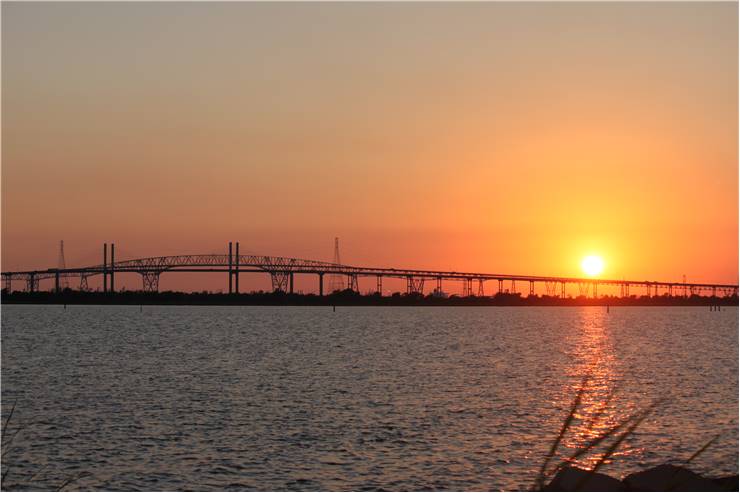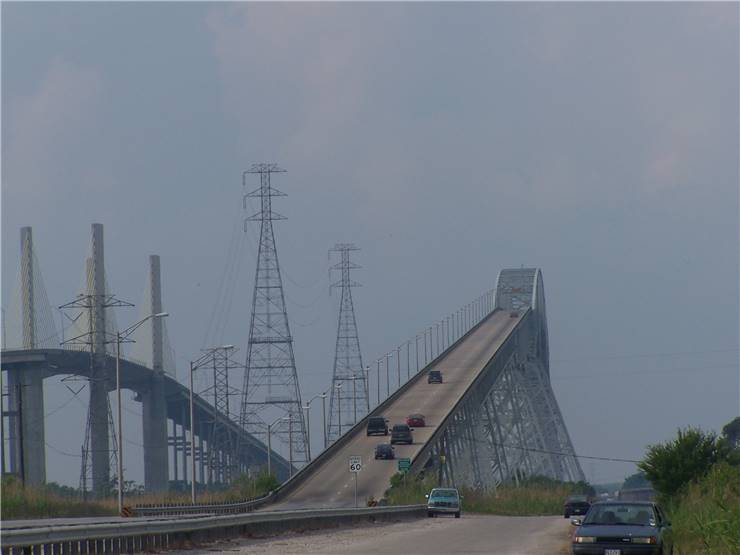Rainbow Bridge Texas -Tallest Bridge in Texas
Rainbow Bridge in Texas is an impressive bridge structure spanning the shores of the Neches River just upstream from Sabine Lake in Southeast Texas. As a part of the State Highway 87 and State Highway 73, it effortlessly connects the city of Port Arthur in Jefferson County with the Bridge City in Orange County. Built in under 3 years between 1936 and 1938 out of concrete and steel and utilizing the Cantilever through truss structure to distribute its considerable weight to the support beams and abutments, this bridge aimed to not only satisfy the traffic needs of the nearby areas but also to provide the residents of upstream city of Beaumont with enough water clearance below its main arch to allow passage of the incredibly large ships and water platforms that were built in the nearby Bethlehem Steel Beaumont Shipyard. Because of this requirement, this incredibly tall bridge immediately gained the moniker of the tallest bridge in Texas.
Initially named the Port Arthur-Orange Bridge, this bridge was eventually renamed into its current name. Several refurbishments and renovations did not change its form but have enabled it to become better-integrated part of the modern US highway network. Today, it provides only a westbound motorway service for travel over the Neches River.
The Rainbow Bridge at Port Arthur features cantilever through-truss structure that is easily identifiable by its location of traffic deck that is carried along the bottom cord and trusses that are located on either side of the bridge and connected by cross-bracing at their tops. The large truss structure was designed to withstand heavy loads, which was not an easy feat due to the non-standard height and span size of this large bridge.
In 1994, Rainbow Bridge in Texas was listed on the National Register of Historic Places and was also listed on MPS list under Historic Bridges of Texas entry.
Origins and Commission
During the first few decades of 20th century, the Jefferson County and Orange County in the US state of Texas have relied on ferries to transport passengers, motorized cars and cargo across Neches River that separated them. However, as the transport volume started increasing during the 1920s and 1930s, the local governments in that region started forming plans about creating a bridge that would finally relieve the transportation pressure in that part of the US, and enable its large State Highway network to finally gain advantage from new roadways across Neches River.
The proposal for building new bridge between Beaumont and Port Arthur communities was created over very long period of time, most notably, because residents of Beaumont claimed that the bridge would be a direct hindrance to their large shipyard which was famous for building incredibly large ships and sea platforms, including aircraft carriers and offshore oil drilling rigs. In their minds, the community could be better served with ferries or drawbridges, but Port Arthur community insisted on a permanent bridge that would enable the free flow of traffic at all times.
After years of deliberations, and seven years after original presentation of the bridge-building plans, the two communities agreed on the bridge that features road length of 7,700 feet, 5 percent grade, main span clearance of 680-foot (210 m) and water clearance of 177 feet (enough to enable passage of then-largest construction project in the Bethlehem Steel Beaumont Shipyard, the fabled ship USS Patoka that was eventually left unfinished and scrapped). Even though this particular ship never sailed below the bridge, the shipyard eventually managed to produce 72 large offshore drill platforms, becoming one of the largest producers of such structures in the United States.
The leader of the bridge construction was state engineer G.G. Wickline, who received help from P.V. Pennybacker and one of the largest construction companies “Ashe, Howard, Needles and Tammen” which successfully worked on some of the largest bridge projects of that time in the United States.
Construction of Rainbow Bridge in Texas
After seven years of deliberation, the work on the bridge was finally started during February of 1936 with the building of the access roads that would enable easy transport of all the needed materials near the work sites. By the summer of that year, first workers started dying on the site, most notably so-called “Sand Hogs” workers - divers who were responsible working on river piers on the depts of over 100 feet below the water. These divers were the best-paid workers in the entire effort, and the majority of the deaths happened due to “the Bends” - a pressure-related malady that was caused by rising from the depths of water too fast to the surface. Today, this illness is known as decompression sickness.
Two other notable deaths during the construction period happened to the construction foreman Bruce Lytle (30 years old) who was hit in the head by the collapsing steel wall, falling to the sea and drowning, and the painter Marcus Robinson (39 years old) who fell into the water from the 170 feet high main span structure to his death.
During the construction, the hourly wages were increased by $1 to the entire workforce, and only Sea Hogs, divers who worked underwater near piers managed to get the raise to $6.5 per hour (which was several times more than the majority of the other workforce). The difficulty of their work forced them to work only up to 2 hours per day, in two different shifts that lasted between 45min and 1 hour per each dive.
In 1937, work was continuing with such a fast pace that in the summer that two halves of the bridge were finally joined one to another. Workers who finished this feat had to work on the top of the structure of the bridge, almost 180 feet above the surface of the Neches River. When the main span was finished, this bridge officially became the tallest bridge in Texas.
After the bridge was finished and painted, newly christened Neches River Bridge (a name that was again a point of great contention between nearby communities which funded the bridge-building effort) was opened to the public on September 8, 1938. The opening ceremony included the cutting of the ribbon by Mary Elizabeth Mills, daughter of H.O. Mills who originally commissioned the bridge, celebration and public talks at the nearby Yellow Jacket Stadium, and music by several marching bands.
The 50th anniversary of the construction of the Rainbow Bridge was held on September 8, 1988, at the event that was hosted by The Bridge City Chamber of Commerce.
Official Name
The naming of Rainbow Bridge in Port Arthur went as smooth as the initial setting of building plans - which means, it went hard, long and with lots of heated deliberations. Many citizens from Port Arthur wanted to name it “The Port Arthur Bridge,” which included all Jefferson County Commissioners, Port Arthur Jaycees and Rotary clubs, and many other notable citizens. Other proposed names which were favored by Orange County and Beaumont citizens and Orange County Commissioners were “Neches River Bridge,” “The Port Arthur-Orange Bridge,” and “Orange Bridge.”
During one of the long deliberations about naming the bridge, Jefferson County Commissioner H.O. Mills reportedly became very frustrated. He threw his glasses and said that everyone present was, “… acting like a bunch of kids.” Finally, the name was decided, and during the opening to the public the bridge was christened as “Port Arthur-Orange .”
However, this name would be retained for a bit less than two decades. In 1957 a new initiative for naming the bridge was formed by the North Port Arthur Lions Club. They devised a public competition, which led to the submission of a wide array of names. The winning name was “ Rainbow Bridge,” and the earliest of such entries (out of more than 1,000) was located to the young 6-year old Christy McClintock of Port Arthur who managed to fill out her entry with the help of her grandfather. Young Christy McClintock won the prize of $50 in savings bonds, and during the naming ceremony, she told reporters that she liked that name because the bridge very much resembled a rainbow.
Refurbishments and renovations
After being open to the public in late 1938, the bridge remained in constant use by car and truck traffic used both by local drivers, and drivers on the larger US State Highway network.
The first official large refurbishment of the bridge happened in 1992 when the entire bridge was closed for traffic. During that time the bridge was not only repainted, but many of its elements were replaced and reinforced. This includes replacement of the entire concrete deck, widening of the car lanes from 22.5 feet to 28 feet, replacing of the of the concrete-supported spans on each side of the bridge, and even placing concrete bridge rails instead of the old metal ones.
Renovations were not finished quickly, and in 1997 the bridge received additional renovations so that it could better accompany nearby Veterans Memorial Bridge that was built in 1990 just a few dozen yards to the side of it. When the work was done, the entire Rainbow Bridge was reconfigured to handle only westbound traffic over Neches River. All of the right-bound traffic was diverted to Veterans Memorial Bridge.
Veterans Memorial Bridge
Traffic congestion across the Rainbow Bridge pushed the local government of Port Authority, Bridge City, and nearby counties to invest into a new bridge that would reduce the load of traffic across the old Rainbow Bridge and allow easier and quicker passage across the Neches River. The commission for building a new bridge was focused on simpler and easier to build a cable-stayed bridge at the same location as Rainbow Bridge, just a few dozen yards adjacent to it.
The construction of the new Veterans Memorial Bridge started in 1988, and after its completion in 1990, the nearby Rainbow Bridge was closed for long and expensive renovation and reconfiguration. After the opening of the Rainbow Bridge in 1997, Veterans Memorial Bridge was configured to handle eastbound traffic across the Neches River, while Rainbow Bridge handled only westerly travel direction.
Veterans Memorial Bridge is a bit smaller in its size than Rainbow Bridge. Its main span is elevated 43.5 meters above the waters of Neches River, but that is still enough to enable ships and oil drilling platforms created at nearby Beaumont shipyards to reach the sea. Because of this, Rainbow Bridge continues to hold the record for being the tallest bridge in Texas.

